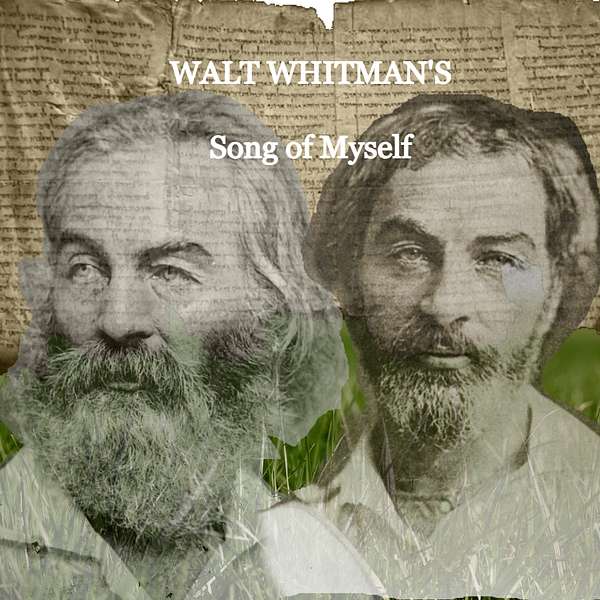
2centspnf
2centspnf
Song of Myself: Section 8 - The Commotion of the City
Hello Lovely listener I'm your host Lindsay and you’re listening to 2cents podcast, Your audible anthology. As this is a series, we shall be analysing another section of Walt Whitman’s song of myself as recited by Guy Mulinder. Without further ado cue the intro.
8
The little one sleeps in its cradle,
I lift the gauze and look a long time, and silently brush away
flies with my hand.
The youngster and the red-faced girl turn aside up the bushy
hill,
I peeringly view them from the top.
The suicide sprawls on the bloody floor of the bedroom,
I witness the corpse with its dabbled hair, I note where the
pistol has fallen.
The blab of the pave, tires of carts, sluff of boot-soles, talk of
the promenaders,
The heavy omnibus, the driver with his interrogating thumb,
the clank of the shod horses on the granite floor,
The snow-sleighs, clinking, shouted jokes, pelts of snow-balls,
The hurrahs for popular favorites, the fury of rous’d mobs,
The flap of the curtain’d litter, a sick man inside borne to the
hospital,
The meeting of enemies, the sudden oath, the blows and fall,
The excited crowd, the policeman with his star quickly
working his passage to the centre of the crowd,
The impassive stones that receive and return so many echoes,
What groans of over-fed or half-starv’d who fall sunstruck or
in fits,
What exclamations of women taken suddenly who hurry
home and give birth to babes,
What living and buried speech is always vibrating here, what
howls restrain’d by decorum,
Arrests of criminals, slights, adulterous offers made,
acceptances, rejections with convex lips,
I mind them or the show or resonance of them—I come and I
depart.
Section 8 begins with an observation of a baby sleeping in its cradle. The poet is not recalling his observations, instead he is discussing them in the present tense. He approaches the cradle and gently lifts the gauze to shoo away flies, in this scene he is overlooking a sleeping infant. Next he observes a young couple having sex by a bushy hill, “The youngster and the red-faced girl” that he peeringly views from the top, similar to how he viewed the infant. Thereafter, the poet observes the scene of a suicide describing the corpse and position of the pistol.
So we begin with these three scenes, could they be related? Maybe the infant was one born out of wedlock and is the child of the youngster and the red-faced girl. Then out of shame one of them, presumably the girl, took their own life. Or perhaps these scenes describe phases of life, the helplessness of infancy, the passion of youth and the conflict of ageing.
Right after describing the macabre scene which had a heaviness to it, the poet switches to a bustling urban scene. We have transitioned from noting where the pistol fell to “The blab of the pavement, tires of carts, sluff of boot-soles, and talk of the promenaders,” or pedestrians. Which takes us back to questioning the scenes at the beginning of the poem, are they just completely random and merely show how all the joy and horror that happens is just a part of life and that while they take place so does “The mindless blab of the pavement, tires of carts” etc. The poet goes on describing all the sounds and sights of the citiscape in a way that makes their bustle symphonic. To run through the descriptions we are told of drivers with interrogating thumbs handling their reins, the clank of shod horses on the granite floor, shouted jokes, hurrahs for popular favourites and the fury of an inflamed mob. The flap of a curtained litter and a sick man in a hospital, there’s also a description of what seems to be a street fight
“The meeting of enemies, the sudden oath, the blows and fall,
The excited crowd, the policeman with his star quickly
working his passage to the centre of the crowd,”
The commotion continues into exclamations of women taken suddenly who hurry home and give birth to babes, The poet then says:
“What living and buried speech is always vibrating here, what
howls restrain’d by decorum,”
Lets analyse the first part: What living and buried speech is always vibrating here. Whitman is making a remark about the vibrancy of the city, so much is happening all at once, presumably in such close space, hence living and buried speech is always vibrating here. The living and buried could refer to the cycle of news or events one happening after the other, each headline kept alive for some time then buried under the oncoming wave of events.
The second part reads what howls restrain’d by decorum, this could refer to emotions of the city dwellers whether they be in despair or pain, and how they are restrained by decorum or the local customs. So while there is much commotion happening and much could to be expressed about it these howls or expressions are restrained, held back, for the sake of convention. I mean fitting for the late 19th century.
The section ends with Whitman describing all the wrong and questionable things around him the “Arrests of criminals, slights, adulterous offers made, acceptances and rejections with convex lips,” He minds all these things unperturbed and departs.
Outro
Thank you for listening to this segment, I appreciate you giving your time. If this is your first listen, I hope this was impressionable enough for you to join me again for another episode. if you’re returning your loyalty is unmatched and received with much gratitude. As always my email is open for any further discussion on a topic, episode suggestions and even submissions;
Till next time :)